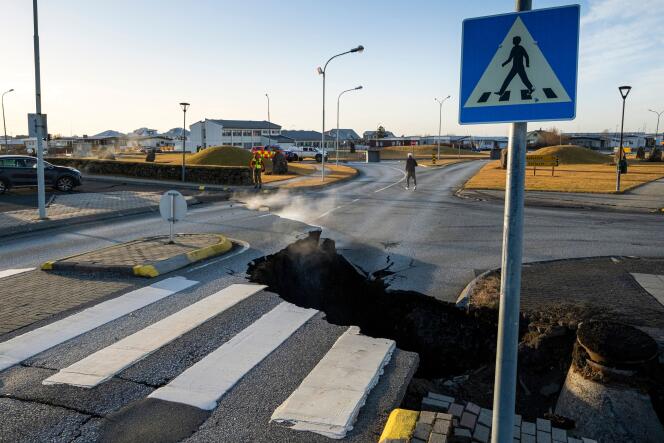Streets gutted by a gaping fault, shattered sections of earth, cracked houses… The damage caused over the past ten days by hundreds of earthquakes in the small port town of Grindavik, in the southwest of Iceland, is already spectacular. Although the 3,700 inhabitants were evacuated on November 11 (they represent 1% of the population), their town, located on the Reykjanes peninsula, remains threatened by a volcanic eruption. On Sunday, November 19, the local Meteorological Office considered it likely that it would occur in the coming days.
The Icelanders are, it is true, accustomed to such disasters: located between the North American and Eurasian tectonic plates in the North Atlantic, their island has around thirty active volcanic systems. In March 2021, lava had already gushed over Reykjanes, near Mount Fagradalsfjall, followed by two more eruptions in August 2022 and July 2023. “But they occurred in remote areas without directly threatening a city, unlike today, explains Michel Sallé, doctor in political science and co-author of the work History of Iceland, from its origins to the present day (Tallandier, 2018). The greatest uncertainty reigns over the consequences that a new eruption could have: they would be very different depending on the location and the trajectory followed by the lava.”
The first damage already concerns Grindavik, therefore. “The special fund dedicated to disasters has 50 to 60 billion Icelandic crowns [325 à 391 millions d’euros]it is reinsured to provide a similar amount in addition, and the State will guarantee the loans if additional needs prove necessary”, explains Thorolfur Matthiasson, an economist at the University of Iceland. Enough to cover a large part of the reconstruction of houses and infrastructure, which will take months. The government also submitted draft laws to guarantee the salaries of Grindavik workers for at least three months.
The international airport is out of reach
In Icelandic memory, the location of this fishing port awakens the memory of January 23, 1973, when a volcano, Eldfell, arose in the night on Heimaey, one of the Icelandic islands of the Vestmann archipelago. Lava flows threatened to block the entrance to the port and destroyed many houses. “The cost of repairs amounted to 5.5% of the country’s gross domestic product “, adds Thorolfur Matthiasson. Eight hundred of the 5,300 inhabitants never returned to Heimaey. And Icelandic inflation jumped from 25% to 42% between 1973 and 1974, partly fueled by tensions in the labor and construction markets, caused by the reconstruction of homes. “For the same reasons, the work in Grindavik could also create inflationary pressures in the months to come,” believes Mr. Matthiasson.
You have 50% of this article left to read. The rest is reserved for subscribers.
